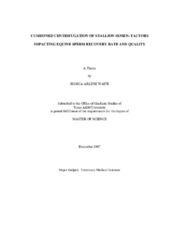| dc.description.abstract | Centrifugation of stallion semen is an integral part of the cryopreservation procedure, primarily allowing for the concentration of sperm and removal of seminal plasma. In addition, centrifugation is required for maximizing spermatozoal quality in semen from some stallions subjected to cooled transport, because of the detrimental effects of long-term exposure to high levels of seminal plasma. The centrifugation process, however, has potential deleterious effects, including reduction in sperm quality as well as loss of sperm numbers. Since centrifugation plays such a crucial role in semen processing, two experiments were designed to evaluate more efficient centrifugation methods to meet the demands of the equine industry. In Experiment 1, semen was centrifuged in two different tube types (nipple- or conical-bottom), using a cushioned technique (Eqcellsire® Component B) with two different extenders (opaque-INRA96 or clear-HGLL). For Experiment 2, nipple-tube centrifugation was conducted at two different g forces (400 or 600) for 20 min, using three different iodixanol cushion media, Eqcellsire® Component B, OptiPrep™, or Cushion Fluid™. Regardless of tube or extender types, centrifugation of semen resulted in sperm recovery rates ≥ 90%; however, centrifugation in INRA 96 extender yielded higher sperm motility values than did centrifugation in HGLL extender (P < 0.05). Cushion type or g force did not impact post-centrifugation semen quality, based on the laboratory values measured (P > 0.05). These results indicate that cushioned centrifugation of stallion semen in either conical-bottom or nipple-bottom tubes can yield a high sperm harvest, while maintaining sperm function. An optically opaque extender, as is typically used in the equine breeding industry, can be used to achieve this goal. The fertility rate (94%; 131/140) following cushioned semen centrifugation in a commercial program this past year indicates that these laboratory results are transferable to the clinical setting. | en |


